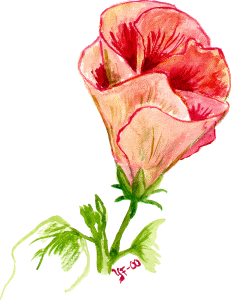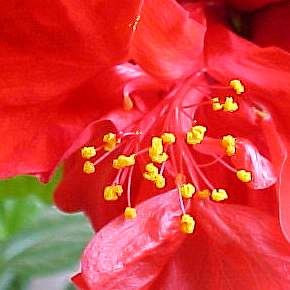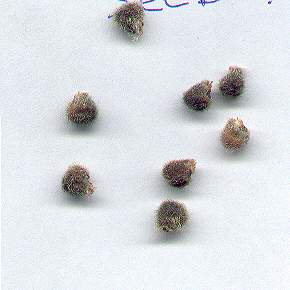|
|
|
 |

Today's complex hybrids are the result of many years of breeding efforts. These varieties possess diverse genetic backgrounds as several different species have been used in the hybridizing work.1 This means that if you cross one variety that has red blooms with one having yellow it will not result in an orange flower, not necessarily either a red or yellow; it may as easily become a purple or a pink. Hibiscus seeds do not breed true, so named varieties can only be obtained through vegetative propagation, that is cuttings. 2 Hybridizing hibiscus is mechanically speaking easy. The difficulty is to obtain new varieties one is satisfied with! Of hundreds of seeds planted maybe one or perhaps two result in a new hybrid worth keeping. | |
Surprisingly, hibiscus has the largest size pollen of any plant. Most plants have microscopic pollen while hibiscus pollen can be seen with the naked eye. The stamens sit in clusters on the prominent staminal column. The pollen sacs are still closed when the bloom opens in the morning but will open during the day. The pollen is yellow and varies in hue between beige and ocher. Sometimes the pollen sacs are empty and then there can't be any hybridizing that day. It's easy to find the pistil as it stands out like some sort of satellite receiver. At the very tip are five hairy stigmas ready to grab onto the pollen grains. The pollen sacs are situated well below the pistil to protect the flower from self pollination. Yes, hibiscus must be cross pollinated. |
 |
 The sacs are open and the pollen ready to use |
To make a cross you obviously need two open blooms. Decide which one you want to be the pod parent. Pick off the flower from the second plant and carefully "dip" the pollen on the stigmas until they are completely covered with pollen. Done! The earlier in the day you can do your hybridizing, preferably as soon as the pollen sacs open, the more you increase your success rate. The pollen must be slightly moist and the stigmas should not have dried out either. Now you have only to wait until the seed pod has expanded and ripened. Well, only and only. Sometimes you get an empty pod without seeds, so called false pod, or it falls off prematurely; why we will deal with in a moment. The seed pod will crack open when the seeds have ripened, after a 35-60 day gestation period depending on the cross, and show several black hairy seeds. You now have to plant the seeds but that is another story. |
There are several factors involved in making your hibiscus set seed:
|
 |
 |
You can't do much to change the above but there are other reasons your plants won't set seeds that you CAN changed: 1. Pollen are perishable and must be used fresh, so the sooner you use it after the flower opened the better it is. An open flower may be kept in the fridge for one or two days if you have nothing to pollinate that day. Put the bloom in a plastic bag and sprinkle a little water over it before you close the bag. Fresh pollen is moist and has the consistency of boiled egg yolk. Grainy or gravelly pollen is useless. 2. The stigmas are most susceptible to pollen directly when the flower opens in the morning. Try to pollinate as early as possible. It may be wise to move the plant into the shade until you have the opportunity to dust on the pollen. You may also spray on a little water before the pollination. |
3. Constant soil moisture after the pollination is essential. If the plant dries out too much the pod may fall off before the seeds are fully developed. 4. Do not remove the spent bloom but let it fall off by itself. It takes time for the fertilization to occur so if you pick off the flower too early it may inhibit the seed production. Only remove the flower if it starts to decompose. Well, that was the hybridizing. Now you only have to plant the seeds and hope for the best. See the introductory page for more information on compatible hibiscus species.
|